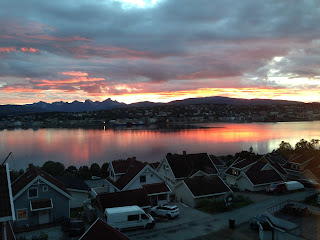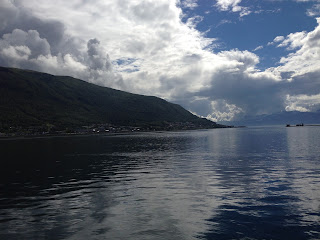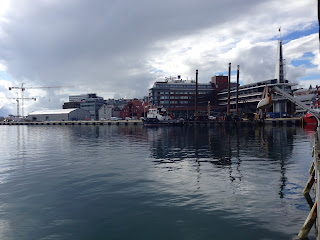Last Sunday I had the chance to join a whale watching tour. I am telling you that this has been a once in a lifetime experience! It is still very early season for whale watching here in Norway but at least the orcas have arrived while the humpback whales are yet to come. The big catamaran "Aurora Explorer" with berth in the harbour in Tromsø city centre took us out further north to the open sea where the whales arrive these days. Next to some pictures and an amazing video I took throughout the boat trip I will also provide you with some scientific information in this entry.
The scientific name of the orca or killer whale is Orcinus orca. Killer whales are mammals which for instance means that they breathe air using their lungs. To get the air to their lungs they use a blowhole which is located on top of their head. As their lungs don´t tolerate water (just likes ours) this blowhole is covered with a muscular flap when the orca is below water. When at the surface the orca opens the blowhole by contracting this muscular flap in order to inhale. Afterwards they close the blowhole again. When diving they hold their breath. While swimming near the surface they tend to dive for 30 seconds or less. When above the surface you can see and hear them breathing. The visible spout of water that rises from a killer whale's blowhole dosen´t come from the lungs.
Water that is on top of the blowhole when the exhale begins is forced up with the exhaled respiratory gases.
Especially in cool air, a mist may form which is water vapor condensing as the respiratory gases expand in the open air.

Killer whales are easy to recognize because of the striking and characteristic black and white pattern.
Behind each eye they have a white eyepatch. Just behind the dorsal fin they have a gray patch called saddle. The dorsal side is black while the underside is white.
It is quite easy to distinguish between males and females. You determine their sex by the form of their dorsal fin. Males´ fins are shaped like a isosceles triangle while females´ dorsal fins are curved. The dorsal fin of a male also tends to be larger.
 |
| This is a male |
 |
| A male on the left, a female in the middle and a male on the right |
As you might already have guessed the orcas don´t stay in Norway all year long. They usually get here around mid-October and stay till February. They come here to feed on herring. Orcas don´t travel alone but in pods. Often several females and their offspring and just a few males live together in one pod. Further, the orcas hunt together working as a team. Orcas have the second-biggest brains among all marine mammals. They show their great intelligence for example by the use of special and diverse hunting techniques. Often they encircle their prey so that it doesn´t know where to go. Then they might even stun the prey with their tail flukes and afterwards feed on the stunned prey.
The diet of orcas differs a lot. They are carnivores. Even though they have teeth they don´t usually chew a lot but rather tear apart their prey so that it gets easier to swallow. Killer whales have no natural enemies, instead many other animals fear them. That´s why they are called killer whales. Even though penguins or seals resting on ice floes might feel safe (as orcas can´t come on land), they are far,far away from being safe. Either the orcas will hit ice floes from below to knock them of or they will create a large wave by swiming side by side and diving below the ice floe in the last second which then washes the prey of the ice floe. Depending on where they are the orcas are able to adapt to their environment very fast and develop different hunting techniques.

Throughout the cruise we even watched different surface characteristics and special behaviours. They are hard to capture on camera but I managed to get a shot of a tail slapping orca as seen on the right.
In the bottom left corner of the below picture you can see a spy hopping orca. We saw some spy hopping on the tour as well. Orcas do this to get an overview of what is going on around them above the surface. They are very curious animals and want to know what is going on.
 |
| surface characteristics |
After all this information please enjoy the following video from the whale
watching trip. As you might recognize when watching the video I didn´t
even know where to look first as the orcas where everywhere and came very
close! I would have expected the orcas to leave when they see a big catamaran
coming but they did the exact opposite. This once again illustrates that
they are very social and curious animals. These animals are not meant to be captured in way to small aquariums drugged up with tranquilizer as tourist attractions. They are meant to to live freely in the earth´s oceans and swim thousands of kilometers in their lifetime.
Credits to the captain Stein-Are, the guide Liga and the rest of the crew from
Arctic Explorer AS for this amazing experience!
 |
| We even saw a calf! |






































